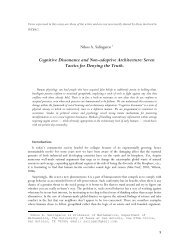You also want an ePaper? Increase the reach of your titles
YUMPU automatically turns print PDFs into web optimized ePapers that Google loves.
FINAL RESULTS/<br />
DATA PRESENTATION<br />
COLLECTION<br />
Floresti windows type<br />
Laslea windows type<br />
street facade in Noul Sasesc and Viscri<br />
Social and Cultural Events group<br />
People involved:<br />
Irina Neacsu (architect student),<br />
Anca Daniles<strong>cu</strong> (art historian student).<br />
in search of old traditions<br />
The Social and Cultural Events Group had the task of making a<br />
research regarding the folkloric and architectural traditions that<br />
still exist and discover the events (holidays, festivals, fairs...) and <strong>cu</strong>stoms<br />
of the place, which define a very typical way of life.<br />
The idea was, on one hand, to propose an archive of the built environment<br />
which can lead further to a code of regulations in the construction field,<br />
and, on the other hand, to discover the possibilities of maintaining the<br />
communities which gave the place life.<br />
The rapid exodus of the Saxons from the 1990s, after the Romanian revolution, has precipitated<br />
sudden great change in the communities. The villages have emptied; the remaining communities<br />
are elderly and impoverished. In 1990, the ethnic mix in the Saxon villages was 70% Saxons,<br />
25% Romanian and 5% Rroma, with a Saxon population of 90.000. Today, the population stands<br />
at less than 20.000, from which, 5% are Saxons, 35% Romanian and 60% Rroma. The<br />
Romanian and Rroma population brought their specific <strong>cu</strong>stoms and traditions and only in few<br />
places there are Saxon traditions which are still kept. (in Richis- the <strong>cu</strong>stom of hanging mistletoe<br />
branches at the windows in may saying that there are girls at that house, is an old Saxon<br />
tradition). The exodus of the Saxons had a big impact on the built environment. Since todays<br />
population is mostly orthodox and catholic, the fortified evangelical churches are not anymore<br />
used for service, and that’s why they are kept in a very bad condition. The houses are mostly<br />
owned by Romanians and Rroma who have a very different tradition in construction and do not<br />
necessarily appreciate so much the appearance and identity of their villages. Those who can<br />
afford to invest are looking more for modern comfort and effects like pebble-dash, crazy paving,<br />
tarmac and Alpine picture windows, statements of the modern world. To educate the locals and<br />
to help them to appreciate the long-term economic benefit of conservation in terms of property<br />
values and tourism could be more effective than State regulation and conservation.<br />
In the next pages is presented a calendar with the major events and holidays<br />
that exist in the Saxon villages of Transylvania nowadays:<br />
the Saxon tradition of <strong>cu</strong>tting the roof to the street facade 15






